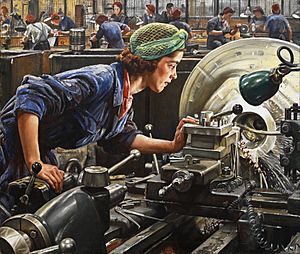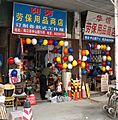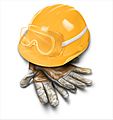Occupational Safety and Health facts for kids
Occupational Health and Safety (often called OHS) is all about keeping people safe and healthy while they are at work. Think of it as a set of important rules and laws designed to protect workers. These rules can be very different from one country to another. Some places have very strict safety guidelines, while others might have fewer.
The idea of having official health and safety rules for workplaces started around 1950. That's when two big groups, the International Labour Organization (ILO) and the World Health Organization (WHO), agreed on common standards for keeping people healthy and safe at their jobs.
Contents
What are Workplace Safety Rules About?
Workplace safety rules cover many different things to make sure everyone stays safe. They look at details like:
- Temperature: Is the workplace too hot or too cold? It needs to be comfortable.
- Clear Paths: Are there things on the floor that people could trip over? Or things that could catch on clothes and cause an accident?
- Clean Air: Rules also cover things like smoking or other things that might cause pollution in the air. They also look at fire risks.
- Facilities: How many toilets should there be for the number of people working?
- Safety Gear: Do workers need special equipment, like hard hats to protect their heads, or safety glasses?
- Working Alone: Is it safe for someone to be left alone at their workplace?
- Fairness: The rights of disabled people are also important.
- Work Hours: How many hours a person can work in a day or week is also part of these rules.
Why are These Rules Important?
Businesses that don't follow health and safety rules can face serious problems. They might have to pay a fine (money as punishment), or even be forced to close down. If an accident happens because they didn't follow the rules, they could be held responsible. This means they might have to pay for injuries or damages.
Who Makes and Enforces Safety Rules?
In places like the European Union, each member state has groups that make sure businesses follow health and safety laws. For example, in the UK, the Health and Safety Executive and local councils create and enforce these rules. They do this under a law called the Health and Safety at Work etc. Act 1974.
In the United States, a law called the Occupational Safety and Health Act was created in 1970. This law led to the creation of two important organizations:
- The National Institute for Occupational Safety and Health (NIOSH)
- The Occupational Safety and Health Administration (OSHA)
These groups work to research safety and make sure workplaces are safe.
Understanding Workplace Risks
It's impossible to be 100% safe all the time, but employers must try their best. They often have to fill out special forms called "risk assessments" (in the UK) or "hazard assessments" (in the USA). These forms show that they have thought about all the possible dangers and have done everything they can to make the workplace safe for everyone.
Related pages
Images for kids
-
Harry McShane, age 16, in 1908. He was pulled into factory machinery in Cincinnati. He lost his arm and broke his leg, but received no help or money for his injuries.
See also
 In Spanish: Seguridad y salud laboral para niños
In Spanish: Seguridad y salud laboral para niños












